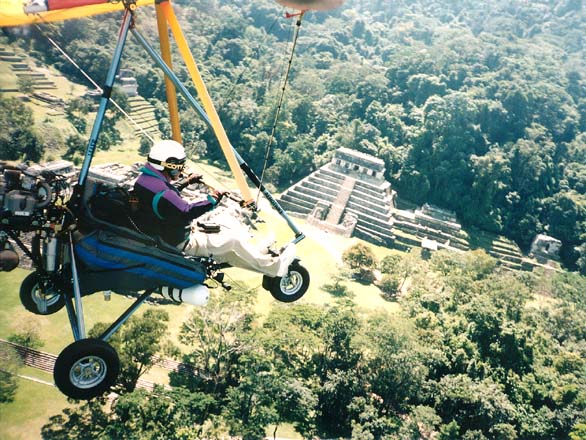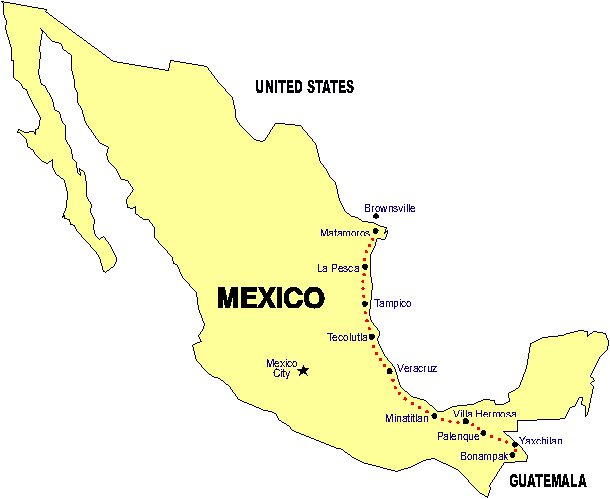
| Mexico Trike trip... |
description of trip . . .
This was a solo trike trip flying an AEROTRIKE from the US/Mexico border, down the east coast of Mexico to the
southernmost Mexican state of Chiapas, to visit the Mayan ruins at Palenque, Yaxchilan and Bonampak. The
round-trip flight included 2200 miles and 34 hours of flying.
route of flight . . .
The trike was hauled on a trailer from Indiana down to (and across) the US/Mexico border at Brownsville, Texas.
The trike was quickly readied for flight at the Matamoros International Airport,
with the flight beginning on February 2, 1998. The route of flight was south along the Gulf of Mexico coast, with
stops at La Pesca, Tampico, Tecolutla,
Veracruz, Minatitlan, and Villa Hermosa, before
flying into the state of Chiapas to the airstrip near the Palenque ruins. From the Palenque airstrip, I flew over
the Palenque ruins (only five miles west of the Palenque airstrip), down to the
Yaxchilan ruins on the Mexico/Guatemala border (83 miles southeast of Palenque),
and to the Bonampak ruins (12 miles southwest of Yaxchilan).
description of aircraft and equipment . . .
The AEROTRIKE-HKS was powered by the HKS 60-hp four-stroke,
two-cylinder engine. Navigation was with a Garmin 12XL GPS, and radio communications were with an ICOM-A22 radio
(radio and GPS mounted on a kneeboard). This AEROTRIKE was equipped with the optional La Mouette Ghost-12 wing, which
allowed cruise speeds from 50 to 75 mph. At the "normal cruise" of 60 to 65 mph, the HKS engine burned about 2.4 gph
of fuel. With the AEROTRIKE standard 13-gallon fuel tank capacity, this gave an approximate five-hours endurance, and
an additional 5-gallons of fuel was carried in a separate container as "cargo" which provided another two hours of
flight capability (after a stop to put the extra gas into the main fuel tank). The new Japanese-manufactured HKS
engine installed on this AEROTRIKE was one of the first flying in the U.S. and it proved to be completely reliable on
this trip, providing good power, very smooth and quiet operation, and excellent fuel economy.
flying an "ultralight" in Mexico . . .
The AEROTRIKE-HKS used for this trip was flown in the United States as an "ultralight trainer" (operating under a
training exemption from the F.A.A.). Under U.S. regulations, it was not allowed to fly across the U.S./Mexico border
in an "ultralight" (or anything other than a regular "registered aircraft"). Also, the status of "ultralights" in
Mexico (especially flown by foreign citizens) is somewhat uncertain. So, for this trip to be possible, I had to
obtain special permission from the Mexican D.G.A.C. (equivalent to our F.A.A.) to haul my trike across the border
and undertake my trip in Mexico.
Mexican airports . . .
On many previous occasions, I had flown larger, faster planes in Mexico, and so I was familiar with the route and
most of the airports on this trip. At the airports I visited with my trike, I received the same great hospitality
that I had always enjoyed when visiting Mexico -- even with my "minimal" Spanish. The airports were secure and well
managed, and the airport personnel were very interested in the "ultralight" and exceptionally helpful.
weather during the trip . . .
After a three-day delay in Matamoros due to high winds and storms, once I began my trip I had acceptable weather and
was able to fly at least several hours each day of my trip. I started flying at sunrise most days, to take advantage
of the calmer early-morning conditions. Still, the Gulf coast of Mexico is often very windy, and winds and
turbulence were a problem on several occasions, including a landing in 48 mph winds in Veracruz on the return-leg of
my trip. That landing was successful but with such strong winds it wasn't possible to turn sideways to the wind to
taxi to the parking area, so airport personnel positioned a huge airport firetruck a few feet in front of the trike
to help block the wind and with the help of fellows at the airport, we removed the wing from the trike and got it
folded up and into its bag to carry to a hanger for the night. Parking "ultralights" in very windy conditions is
usually a big worry, but with a trike it's a simple matter to remove the wing from the trike and lay it completely
flat on the ground (parked for the night at Veracruz) (in a smooth, grassy area)
where it can be staked down and then safely ride out even the most violent storms. When parking a trike for the
night where you can be fairly certain of nothing more than light breezes, you can simply lower the wing so that it
rests on the wing's control bar (at Palenque airstrip, side view)
(at Palenque, front view) and the wing can easily be tied-down.
more photos (with thumbnails) below Mexico map . . .
Rob Rollison
email: info@aerotrek.aero
visit my web sites at...
www.airplanegear.com
www.aerotrek.aero
another story about this flight is at...
www.ultraflight.com/issues/november98/nov98page21.htm

ADDITIONAL PHOTOS . . .
(click for larger photo)
 At Matamoros International Airport, getting set-up for the trip
At Matamoros International Airport, getting set-up for the trip
 at a grass airstrip (next to a banana plantation) near
Tecolutla, preparing to continue the flight south
at a grass airstrip (next to a banana plantation) near
Tecolutla, preparing to continue the flight south
 at the Veracruz International Airport, stopping for the night
at the Veracruz International Airport, stopping for the night
 at the Veracruz International Airport, with the wing put down on
the grass and tied-down
at the Veracruz International Airport, with the wing put down on
the grass and tied-down
 at Villa Hermosa Airport, a brief stop because of rain
at Villa Hermosa Airport, a brief stop because of rain
 parking at the Palenque airport
parking at the Palenque airport
 at the Palenque airport with the wing lowered so the control bar
is on the ground
at the Palenque airport with the wing lowered so the control bar
is on the ground
 at the Palenque airport
at the Palenque airport
 testing the wingtip camera, with several local folks who were
looking at the trike
testing the wingtip camera, with several local folks who were
looking at the trike
 Palenque ruins
Palenque ruins
 Palenque ruins
Palenque ruins
 Palenque ruins
Palenque ruins
 Palenque ruins
Palenque ruins
 Palenque ruins
Palenque ruins
 Palenque ruins
Palenque ruins
 early morning flight from Palenque to Yaxchilan, starting to
fly over fog-covered valley
early morning flight from Palenque to Yaxchilan, starting to
fly over fog-covered valley
 flying over the Yaxchilan ruins, on the river separating Mexico
from Guatemala
flying over the Yaxchilan ruins, on the river separating Mexico
from Guatemala
 approaching the airstrip near the Yaxchilan ruins
approaching the airstrip near the Yaxchilan ruins
 the Yaxchilan ruins
the Yaxchilan ruins
 meeting a group of archaeologists and biologists working at the
Yaxchilan ruins (the fellow second from the right is Ian Graham, who works for the Peabody Museum at Harvard
University)
meeting a group of archaeologists and biologists working at the
Yaxchilan ruins (the fellow second from the right is Ian Graham, who works for the Peabody Museum at Harvard
University)
 preparing to depart the Yaxchilan airstrip (chicken on the runway)
preparing to depart the Yaxchilan airstrip (chicken on the runway)
 Bonampak airstrip visible (Guatemala in the far distance to the east)
Bonampak airstrip visible (Guatemala in the far distance to the east)
 over the Bonampak ruins (metal roofs have been placed over certain
buildings and monuments to protect them from rain)
over the Bonampak ruins (metal roofs have been placed over certain
buildings and monuments to protect them from rain)
 Bonampak ruins
Bonampak ruins
 one of the famous murals at the Bonampak ruins
one of the famous murals at the Bonampak ruins
 Bonampak airstrip
Bonampak airstrip
 on return flight, a brief stop at the grass airstrip (next to
a banana plantation) near Tecolutla
on return flight, a brief stop at the grass airstrip (next to
a banana plantation) near Tecolutla
 northbound, flying over the river at Tampico
northbound, flying over the river at Tampico
 while northbound on my last day in
Mexico, I made a brief stop at a private airstrip south of La Pesca to refuel and met some local people who drove
or rode up after I had landed
while northbound on my last day in
Mexico, I made a brief stop at a private airstrip south of La Pesca to refuel and met some local people who drove
or rode up after I had landed
|
Aerotrek Aircraft, Inc.
34 E. Antioch Road, Bloomfield, Indiana 47424 U.S.A. phone: 812-384-4972 email: aerotrek.aero@gmail.com visit our web site at... www.aerotrek.aero visit our web site at... www.airplanegear.com |